
I have a deep appreciation for architecture, and a sincere admiration for those who design and create spectacular homes. Through my blog, I have found quite a few kindred spirits who love architecture as much as I do. One of these kindred spirits suggested that I begin a series in which I interview architects and architectural designers and get their perspective on what is happening in the architectural scene of the 21st century.
The first architectural designer that I am profiling is based in Atlanta, Georgia. His name is William T. Baker, although he goes by Bill. Whenever I see a 'William T. Baker' sign up on an empty lot or on the lawn of a home that is being renovated, I know that it is going to be a spectacular project. Bill is known for his classic style and exquisite attention to detail. He is extremely versatile and has one of the best eyes for scale and proportion in Atlanta. It is interesting to note that designer Suzanne Kasler, who also has an amazing eye for scale, proportion, and detail, selected William T. Baker & Associates as the architectural firm on her recent remodel of a classic 1930s Buckhead estate.
The following contains the questions I posed to Bill, and his beautifully worded answers. Interspersed with the questions are examples of some of the houses that have inspired him, as well as examples of homes that he and his firm have designed over the past 20 years (unless noted as otherwise).
William T. Baker
Q: How did you decide to pursue a career in architecture?
A: In retrospect, my childhood was very rich visually. My father was a nationally acclaimed furniture designer, and I would watch him draw his designs on thick ivory-colored paper at his drafting table. Sometimes when he would let me, I’d climb up onto the tall wooden stool next to his chair and trace around his French curve templates or carefully inscribe circles with a compass. I developed a love for drawing and an eye for detail at an early age. My father taught me how to draw cubes and rectangles in three dimension. In fact, I was the only child in my kindergarten class who knew how to draw objects in perspective! By the time I entered second grade, I was able to sketch a farmyard scene and show the barn in correct perspective with its shadows.
In 1975, I enrolled at Auburn University planning to major in architecture after my second year. This seemed to be a good plan given my lifelong love of architecture and the artistic talent I had demonstrated. However, I was disappointed to find that the curriculum had largely abandoned its classical foundations and had embarked on a new aesthetic direction that didn’t appeal to me. Furthermore, during my sophomore year, many of the graduating architecture students began sharing stories of firms laying off architects rather than hiring new ones. The country was still reeling from the effects of the Arab oil embargo, inflation was rampant, and construction-related businesses had few entry-level openings. So, I declared a major in business finance, thinking this would result in better job prospects.
After graduating in 1979, I found that the prolonged recession had affected the job market for business graduates, and my best efforts were for naught. I was in exactly the situation I had hoped to avoid! I accepted a job selling insurance but this company soon went out of business. My career seemed to be off-track, and I searched for a new direction. During this time, I received an unexpected and much-needed word of encouragement. I casually mentioned to someone that if these were the best days of my life, as the old saying goes, then I was in trouble. This wise person responded, “The early years of a young person’s life are not the best years, but rather the most fun. The best days are still ahead.” I held onto these words as I wondered what the future held in store for me.
Like many of my peers during this time, I applied to a graduate school of business to earn a master’s in business administration. Surely with an M.B.A. from a good school, I would have success securing a better job. But, shortly after applying to Vanderbilt University in Nashville, a chance meeting completely changed my plans. On a whim, I went to see an executive recruiter to find out which major within the M.B.A. program was most in demand. He confirmed my strategy of pursuing a graduate degree, but suggested I attend Emory University in Atlanta. He said registration for the fall class was still open and that I should apply immediately. This short conversation would impact the course of my life in a way I could never have imagined at the time.
Moving to a large city where I had no family contacts and I knew no one was a daunting task. But I had the hope of a new beginning and new opportunities. My spirits were high as I entered the fall class of Emory’s Graduate School of Business in 1980.
This beautiful home was an award winning design for Bill Baker. I admire it every time I pass it, and sometimes plan my daily dog walks so I can walk by and admire the home with the morning light shining on the front.
Q: How did you make the transition from Business to Architecture?
A: After graduating two years later, I obtained that all-important job for which I had worked so hard. As an in-house consultant for Trust Company Bank, I was engaged in projects for senior executives that allowed me to see many sides of the banking business. I was promoted to officer of the bank after one year, but something wasn’t right. My first love was still architecture, and deep inside I knew that I was wasting my real talent. I was restless.
One morning in the summer of 1984, the major Atlanta newspaper ran an article about a local real estate developer, Martin Marchman. He was making a name for himself by building million-dollar speculative homes. This was the first time the city had seen anything like this on such a large scale. Job growth among Atlanta’s corporate community was strong, and Marchman was building new homes to meet the needs of the Fortune 500 executives moving to Atlanta. Suddenly, I had an idea! Why not contact Marchman to inquire if I could work for him as a business consultant? At least that way I could be around architecture. Marchman suggested that I might work in his in-house architecture department, which was run by Steven Fuller. After meeting with him, Fuller decided the best fit would be for me to administrate the architectural control committees for Marchman’s numerous subdivisions. I was happy to accept the job and began to learn all I could about reading working drawings and the construction of houses.
I could not have asked for a better education than the one I received in my daily conversations with builders and tradesmen. My job was to confirm that the houses were being built according to the approved plans. When I would question why a particular detail didn’t look like the approved plan, the builder or carpenter would review the drawings with me, and in some cases, thank me for my keen eye. In a very short period of time, I learned a great deal about construction drawings and developed a respect for the people in the field who are responsible for turning those drawings into the reality of a finished home.
Back in the office, I got to use my drafting skills. I received the necessary critiquing to help me develop good lettering and line quality. Within a couple of weeks, I was able to draw exterior facades and make revisions to floor plans. I learned the fundamentals of dimensioning and standard sizes for doors, windows and plumbing fixtures. I enjoyed drafting and practiced in the evenings to further develop my skills. By the end of the first year, I moved on to begin a consulting business administrating architectural control committees for developers in Cobb County, Georgia. The builders and real estate agents in these subdivisions sought my opinion about ways to improve the layout and overall aesthetics of their plans. My suggestions were well received, and I was asked to revise kitchens, bathrooms and exterior facades.
Wishing to gain even more knowledge, I studied Edward Muller’s classic textbook Reading Architectural Working Drawings, memorizing the terminology and construction standards. In addition, I retained the services of a structural engineer to help me properly detail my foundation and wall sections. My reputation grew, and within the year, I was drawing complete home plans. These early houses were relatively simple, but they were perfect for my level of experience. The knowledge I learned from the builders, combined with my self-study and inherent abilities, allowed me to succeed. I remain indebted to those first builders who gave me the chance to prove myself.
A magnificent William T. Baker & Associates Tudor style estate in Greenwich, Connecticut
Q: What has inspired you as a designer?
A: We lived in a beautiful Georgian-style house that my father had built in Nashville, Tennessee. It was full of details that caught the attention of my young eyes. Whether it was the graceful curved staircase in our foyer or the dentils in the paneled library, the unique details of this house always provided me with something of interest to contemplate.
My hometown of Nashville was filled with important architecture. My parents and I visited Centennial Park, where I climbed the oversized steps of its replica of the Athenian Parthenon. I was impressed by its huge bronze doors, painted friezes, classical statuary and the grandeur of Greek architecture. It was a most memorable introduction to classical architecture.
When I was a teenager, I had the pleasure of visiting Cheekwood, one of America’s great treasure houses. Built in 1929, it was like a grand dame sitting high on a hill, overlooking the rolling hills and meadows of the surrounding countryside. My interest in this house consumed me for years. It was so large, so exquisitely designed, and so perfect in its setting and gardens, that I found myself exploring it whenever I could. I eventually served as a guide for the Nashville Public School’s Christmas tour of Cheekwood. I took great delight in opening the children’s eyes to the things that made the house so special. I wanted them to leave with more than just the memory of the seasonal decorations. I wanted them to recognize an egg-and-dart molding or a Palladian window. I knew firsthand the excitement that could come with an early love of exceptional architecture.
I was also significantly influenced by two books, American Vignola by William Ware and Edith Wharton’s The Decoration of Houses. These two books opened the mysteries of classical architecture, proportions, and scale to me. I referred to these books over the years and through them came to understand the principles of classicism and to develop a discerning eye for what is, or is not, in “good taste.”
Cheekwood, the limestone mansion in Nashville that was modeled after the grand English houses of the 18th century, was an inspiration for the young Bill Baker.
Q: What is one of your favorite styles of architecture?
A: One of my favorite styles of architecture in America is 18th century French Colonial. About a century after the English had begun to settle the Northeastern territories, the French were busily populating the rich agricultural lands along the great Mississippi River and establishing what would become the port of New Orleans. The Frenchmen who settled these lands in the 1700’s built cottages that differed from their New England counterparts in several distinctive ways. These houses usually had hipped roof with extended porches. In addition to hinged casement windows, these homes have double French doors opening out onto the porches. Because heat, rather than cold, was the environmental challenge of this region, windows were larger and doors more numerous to aid in the ventilation of the interiors. The chimneys were still centrally located within the plan, but are not as massive as those of the Northeast and Virginia.
These colonial French homes were often raised above the ground in order to avoid the dampness of the soil. Sometimes, the main floor is raised a full story on wood or brick piers with the resulting lower level devoted to cooking, storage, and servants quarters. Two good examples from this period are the Bolduc House (1785) and Amoureaux House (1792) of Saint Genevieve, Missouri. The floor plans of these homes range from two rooms with a central chimney to the more elaborate center hall plan flanked by rooms of equal size on both sides. In this later plan, the chimney moves to the outside walls and is duplicated in each room to provide warmth in the short winters. An example of this form is illustrated in the Felix Valle House (1818), also of Saint Genevieve.
While the majority of these homes are wood clad in cypress, others have masonry walls clad in concrete or tabby stucco. The roofs are generally of a less steep pitch than those of the Northeast and have deeper eave overhangs to cast shadows in the hot summers and throw the rain water away from the foundation. In more elaborate homes, the columns of the porches were built of brick and veneered in stucco and white washed to resemble the columns of the classical orders. Colonial French architecture was conscious of the classicism of France but tended to express it most frequently in the columns of the exterior porches rather than in elaborate door surrounds or entablatures under the rooflines.
Rear view of Bolduc House, St. Genevieve, Missouri, circa 1770, one of the best preserved examples of French Colonial style architecture
Q: What type of projects do you work on?
A: I concentrate on designing modern classics, whether they are houses, furniture, books, and, more recently, interiors- all of impeccable taste and quality. These two factors – taste and quality- are the keys to my success. Above all, I design for the consumer’s needs first, not my own. I approach each design as a unique expression of artistic merit. I feel confident that my reluctance to follow the latest trend has positioned me for these lean times because my designs are timeless and will hold their own.
A recent renovation project by Bill Baker; the home was taken down to the studs, and the exterior was completely transformed. I love the classic details such as the portico, the gable, the trim above the doors.
Q: What projects are you working on now?
A: One of my most interesting projects right now is a five unit townhouse group at 39 West Wesley Road NW half a block off Peachtree Street in Atlanta. The façade of the building is made up of hand-carved limestone and brick with a slate roof in the style of a Regency period building. It is an excellent example of the type of building that makes a smooth transition from a high-rise urban corridor into a residential neighborhood. The detailing and scale of the building is of a very high caliber. Another project of interest is the house located at 1795 West Wesley Road NW. This charming New England shake style home has been chosen to be the 2009 Christmas Show House benefiting the Alliance Theater. In addition to these projects, we are working on two equestrian estates, a remodel of a historic Druid Hills home, and a new home to be built on the lake at Reynolds Plantation. Even in this challenging economy, some people are taking advantage of the downturn to build now.

The Connecticut Back Country style home designed by Bill Baker is going to be the Atlanta Homes and Lifestyles 2009 Christmas House. This AH&L showhouse is always my favorite showhouse of the year, and this year's showhouse features a top notch roster of talent, including Suzanne Kasler, Phoebe Howard, Bob Brown, John Oetgen, Beth Webb, Barbara Howard, and Mimi Williams (for full list, please see the AH&L blog). The home is on the market; to see the listing, please go here.
Q: What’s something you shouldn’t skimp on when designing a home?
A: Families should always concentrate on getting their room sizes correct from the beginning of the project. That is the one thing that can’t be changed later once the house is built. There’s nothing more tragic than seeing a family undersize their home only to find that it doesn’t meet their needs later. This is the one area I always encourage my clients not to skimp on.
This home was completed recently, and is one of my favorite Bill Baker's designs. So lovely is the home, and so well designed for its lot, it elevates the entire feel of the neighborhood.
Q: Is there a fad you hope you never see again?
A: Yes, the houses built in the 1950’s and 60’s that we refer to as “Ranches”. These houses, for the most part, have proven to be a design that has not stood the test of time. Their floor plans are inevitably obsolete for today’s lifestyle with their low ceilings, small bathrooms and closets, and kitchens usually located on the front of the house. Who thought that was a good idea? Over time, these houses are torn down rather than remodeled. As such, they have proven to be the ultimate anti-green architecture as the resources used to build them end up in the local land fill.
Here are some more William T. Baker & Associates designed homes that captured my eye:
A French enfilade style home designed by William T. Baker and Associates
Homes designed by Bill Baker and his team always seem to work so beautifully with the specific features of their landscape, and because of this they never look forced.
This beautiful home sits atop a crest, and fits in so well to the curves of the lot. The landscape design is by LandPlus, one of the premiere landscape architecture firms in Atlanta.
I hope you enjoyed this interview with William T. Baker, Principal of William T. Baker & Associates, an Atlanta based architecture firm. As you can see in example after example contained in this post, Bill Baker's designs are classic and timeless, rooted in the architectural principles and details that stand the test of time. For more information on his firm, please see his
website. Bill also
has a blog with a lot of interesting perspectives on architecture and design.

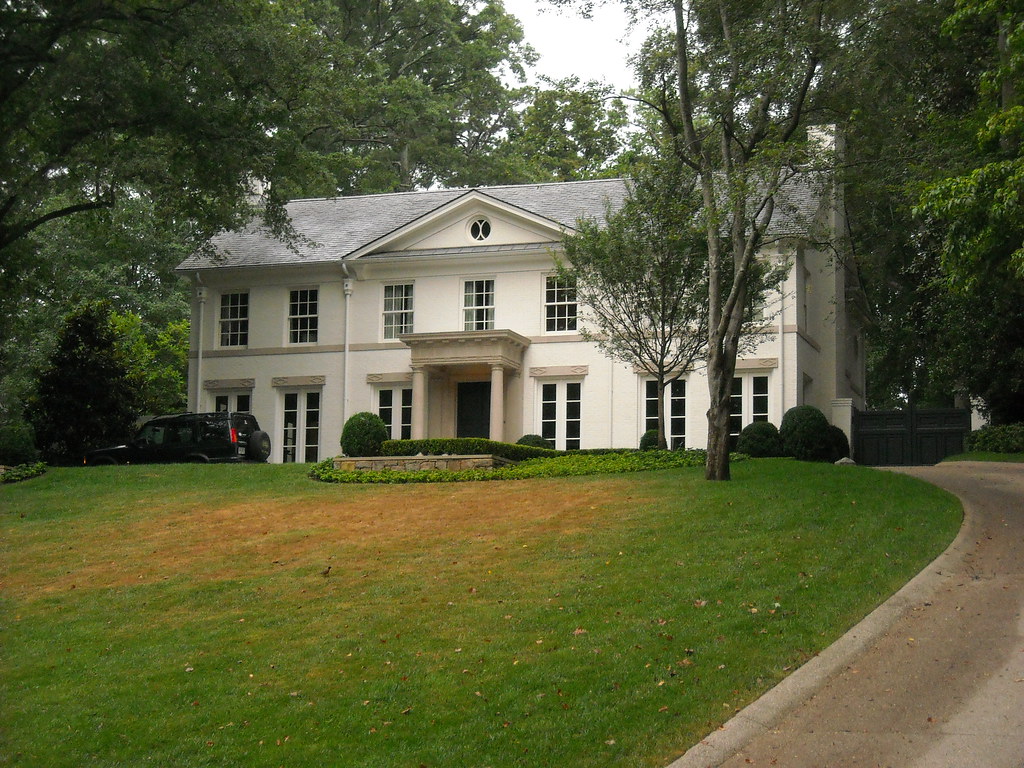
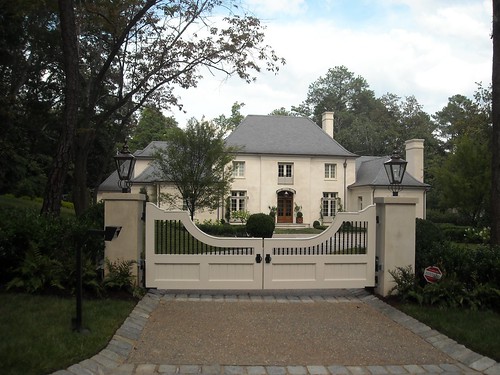
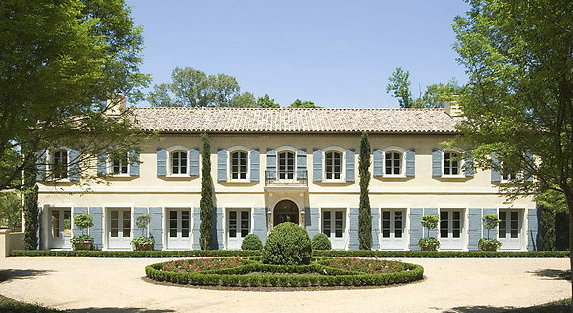




![]()
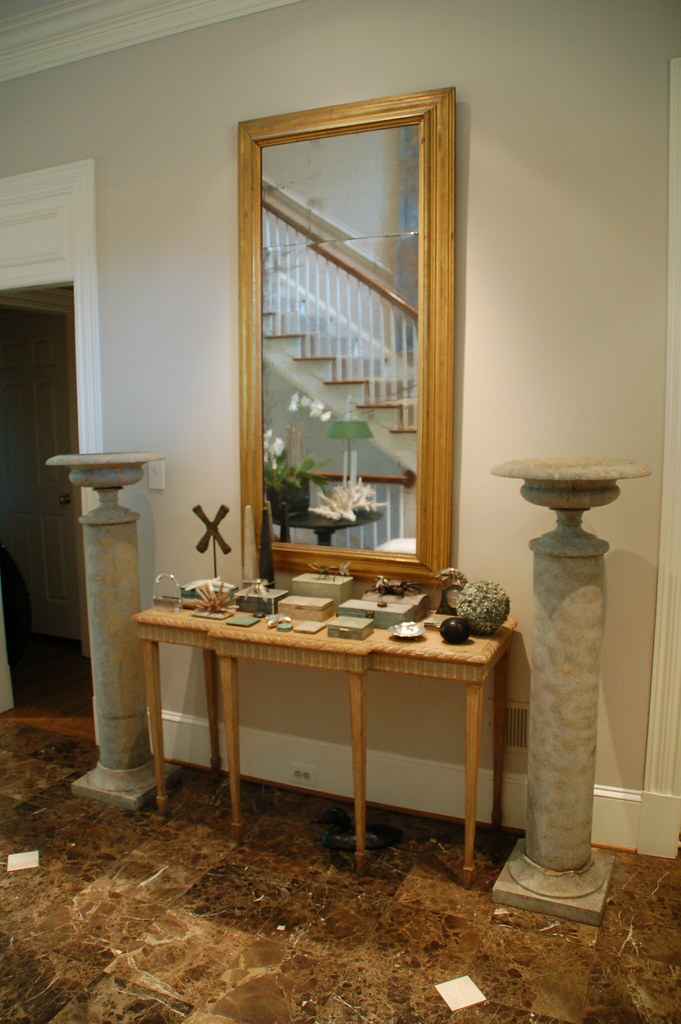
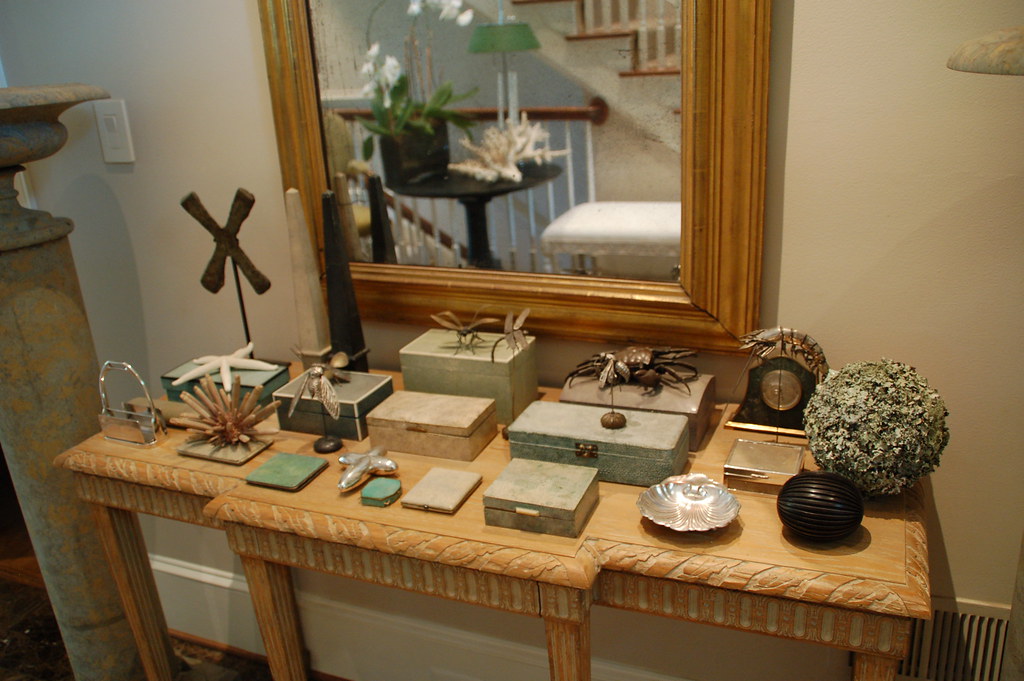

![]()

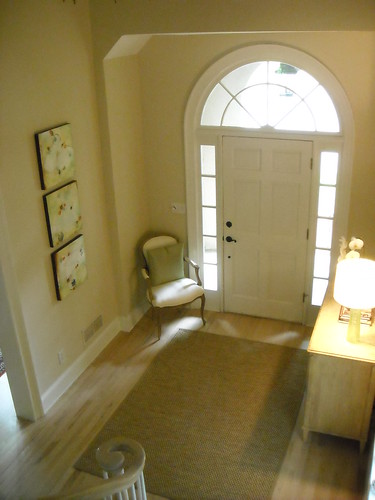
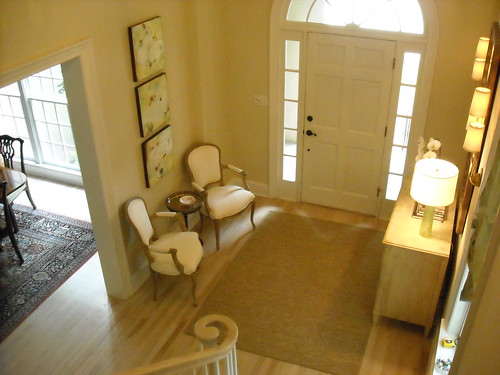

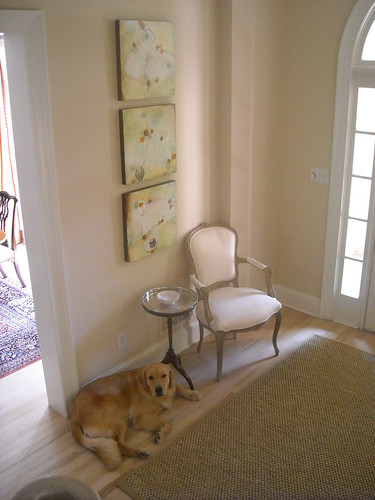
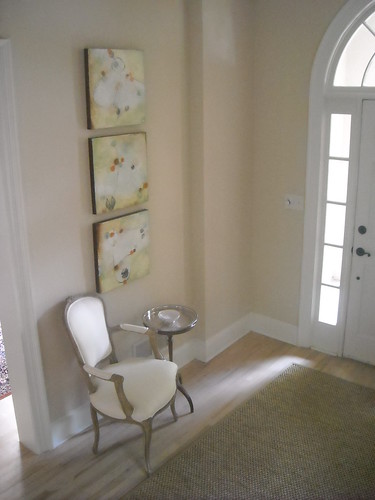
![]()
 I recently learned that not only is Gigi an avid real estate afficionado, but she is also an antique dealer who travels to Europe to find beautiful pieces to sell to customers far and wide. Here are two pieces that caught my eye when looking at her inventory. This pillow is made from a fragment of 18th century French tapestry that was hand woven in a color palette typical of early 18th century textile design. The tapestry is framed in a brown velvet ribbon from France, and finished off with high quality linen. It measures 10 inches by 20 inches, and is priced at $395.
I recently learned that not only is Gigi an avid real estate afficionado, but she is also an antique dealer who travels to Europe to find beautiful pieces to sell to customers far and wide. Here are two pieces that caught my eye when looking at her inventory. This pillow is made from a fragment of 18th century French tapestry that was hand woven in a color palette typical of early 18th century textile design. The tapestry is framed in a brown velvet ribbon from France, and finished off with high quality linen. It measures 10 inches by 20 inches, and is priced at $395. 
![]()

![]()
